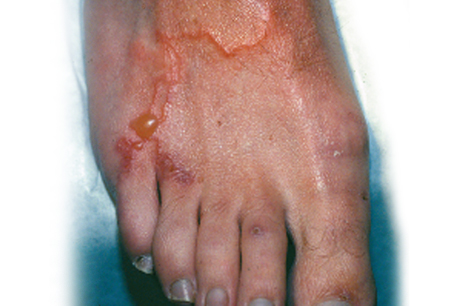Resumo
Definição
História e exame físico
Principais fatores diagnósticos
- recent travel to tropics or subtropics
- barefoot beachgoer/sunbather
- creeping, raised, erythematous track
- intense pruritus
Outros fatores diagnósticos
- vesiculobullous or papular lesions
- folliculitis
Fatores de risco
- recent travel to or residence in an endemic area
- walking barefoot and/or sunbathing on contaminated beach
Investigações diagnósticas
Primeiras investigações a serem solicitadas
- no test required: diagnosis is clinical
Investigações a serem consideradas
- skin scrapings/biopsy
Novos exames
- epiluminescence microscopy
Algoritmo de tratamento
non-pregnant adults and children
pregnant
no response to initial treatment or relapse
Colaboradores
Autores
David J. Diemert, MD, FRCP(C)

Professor
Departments of Medicine and Microbiology, Immunology and Tropical Medicine
The George Washington University School of Medicine and Health Sciences
Washington
DC
Disclosures
DJD declares that he has no competing interests.
Peer reviewers
Eric Caumes, MD
Professor of Infectious and Tropical Diseases
Universite Pierre et Marie Curie
Vice Chairman
Department of Infectious and Tropical Diseases
Hopital Pitie-Salpetriere
Paris
France
Disclosures
EC is an author of a number of references cited in this topic.
Jorg Heukelbach, MD, PhD
Professor
Department of Community Health
School of Medicine
Federal University of Ceara
Ceara
Brazil
Disclosures
JH is an author of a number of references cited in this topic.
Jill Weatherhead, MD, PhD, CTropMed
Assistant Professor of Pediatric Tropical Medicine
Baylor College of Medicine
Houston
TX
Disclosures
JW declares that she has no competing interests.
Peer reviewer acknowledgements
BMJ Best Practice topics are updated on a rolling basis in line with developments in evidence and guidance. The peer reviewers listed here have reviewed the content at least once during the history of the topic.
Disclosures
Peer reviewer affiliations and disclosures pertain to the time of the review.
References
Key articles
Feldmeier H, Schuster A. Mini review: hookworm-related cutaneous larva migrans. Eur J Clin Microbiol Infect Dis. 2012 Jun;31(6):915-8. Abstract
Tremblay A, MacLean JD, Gyorkos T, et al. Outbreak of cutaneous larva migrans in a group of travellers. Trop Med Int Health. 2000 May;5(5):330-34.Full text Abstract
Davies HD, Sakuls P, Keystone JS. Creeping eruption. A review of clinical presentation and management of 60 cases presenting to a tropical disease unit. Arch Dermatol. 1993 May;129(5):588-91. Abstract
Reichert F, Pilger D, Schuster A, et al. Epidemiology and morbidity of hookworm-related cutaneous larva migrans (HrCLM): Results of a cohort study over a period of six months in a resource-poor community in Manaus, Brazil. PLoS Negl Trop Dis. 2018 Jul 19;12(7):e0006662.Full text Abstract
Heukelbach J, Feldmeier H. Epidemiological and clinical characteristics of hookworm-related cutaneous larva migrans. Lancet Infect Dis. 2008 May;8(5):302-9. Abstract
Blackwell V, Vega-Lopez F. Cutaneous larva migrans: clinical features and management of 44 cases presenting in the returning traveller. Br J Dermatol. 2001 Sep;145(3):434-7. Abstract
Caumes E, Carrière J, Datry A, et al. A randomized trial of ivermectin versus albendazole for the treatment of cutaneous larva migrans. Am J Trop Med Hyg. 1993 Nov;49(5):641-4. Abstract
Reference articles
A full list of sources referenced in this topic is available to users with access to all of BMJ Best Practice.

Differentials
- Larva currens
- Gnathostomiasis
- Fascioliasis
More DifferentialsLog in or subscribe to access all of BMJ Best Practice
Use of this content is subject to our disclaimer